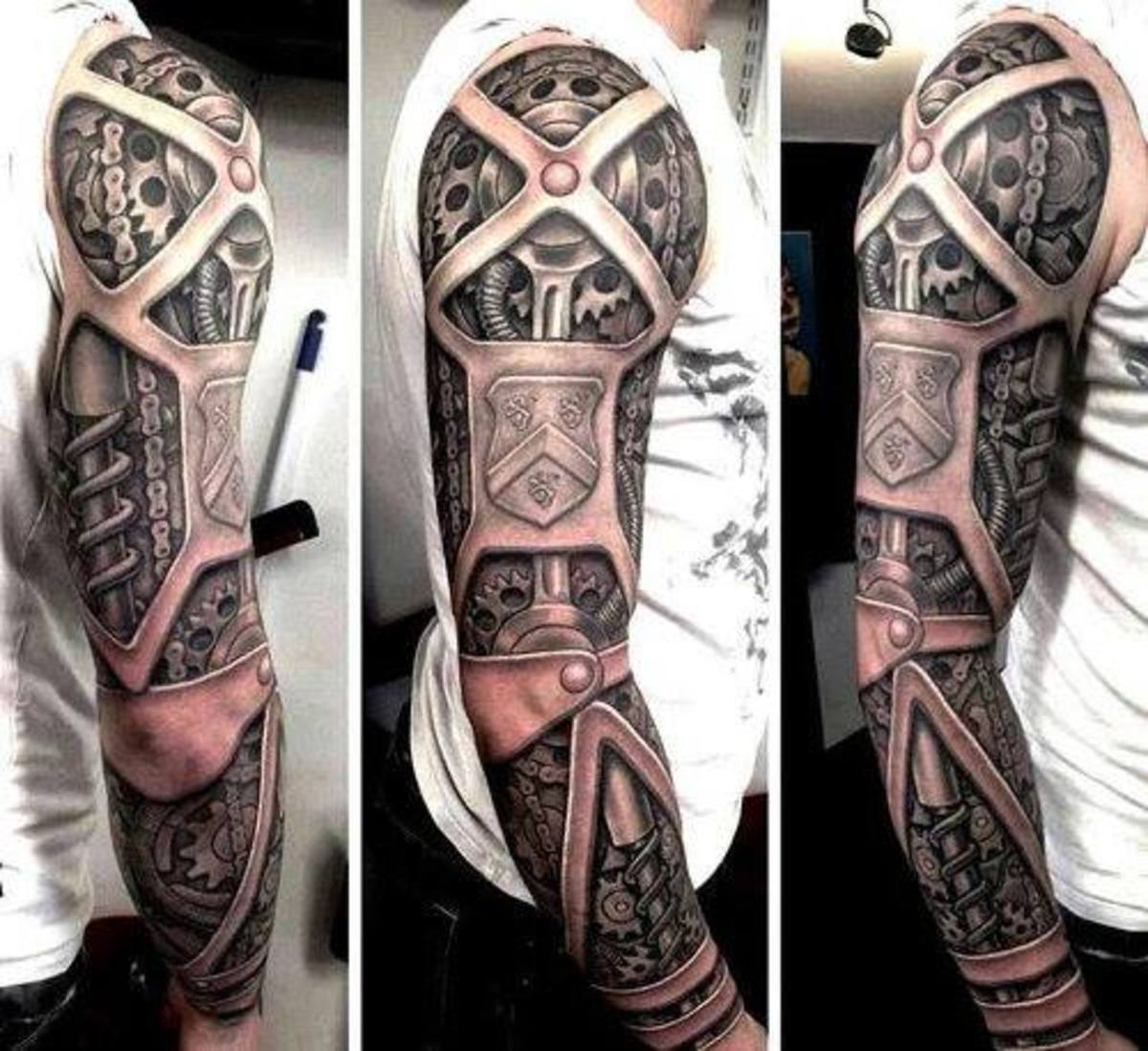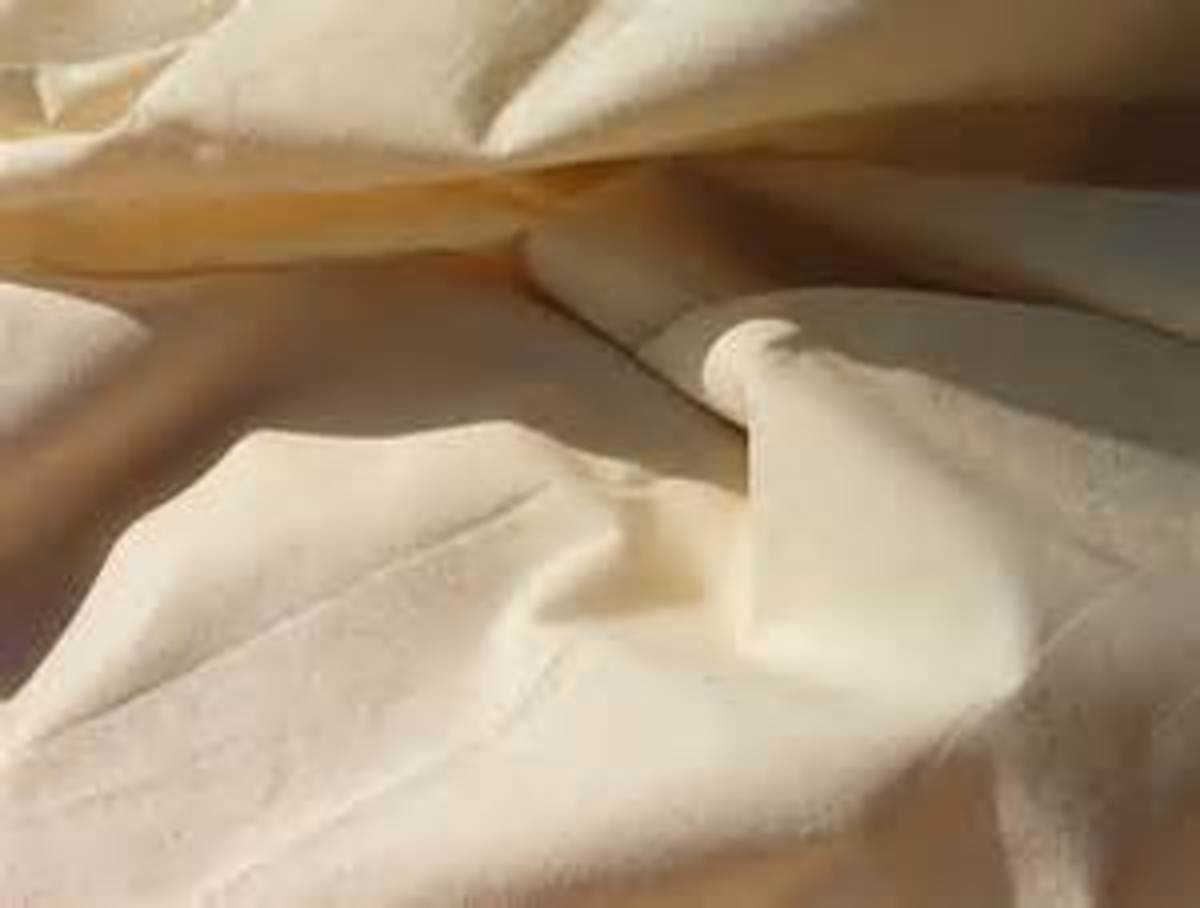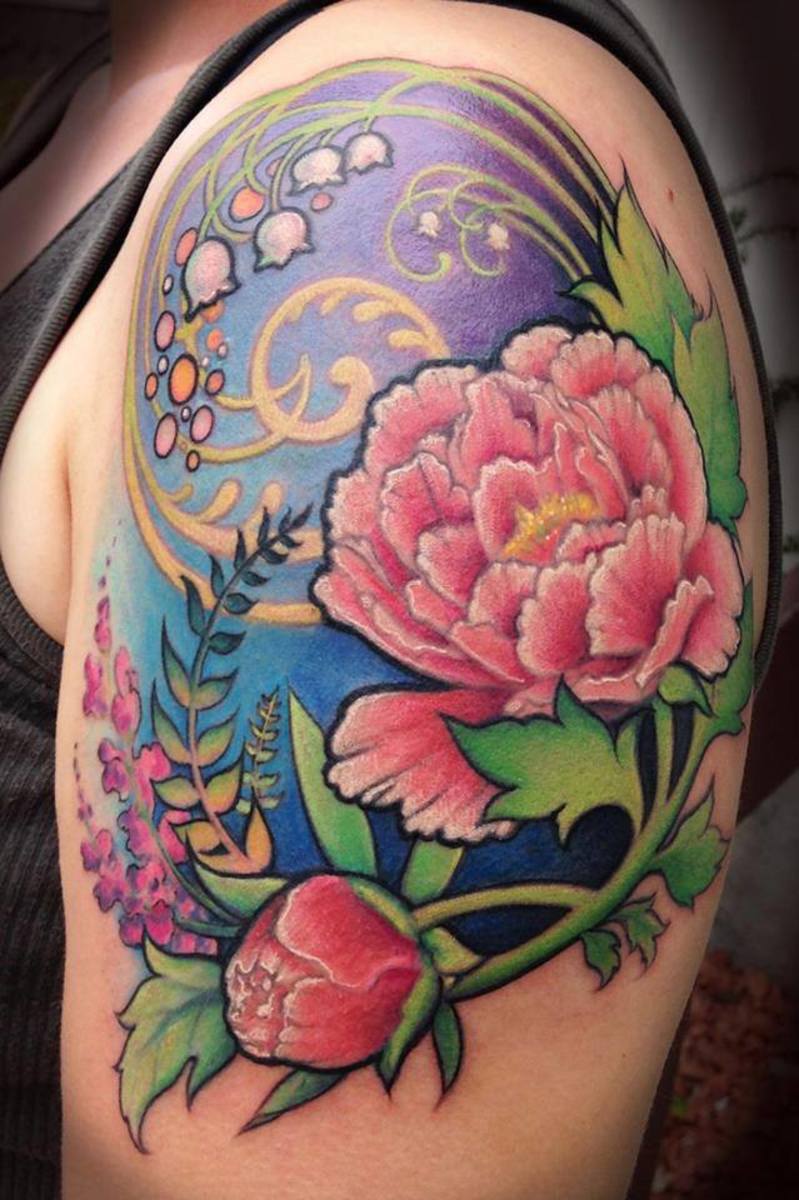
Wrapping your tattoo in cling film or plastic wrap is believed to have developed from the '60s and '70s Biker gatherings. Freshly tattooed Bikers were brazenly ripping off their bandages repeatedly, showing off their new tattoos, blood and ink oozing everywhere.
The "cling film" legend goes like this: one of those bike enthusiasts decided to wrap his new tattoo in see-through plastic, so he could show all his mates without taking off its cover. It worked. His mates could now see his new tattoo, and he didn't flick blood and ooze around.
(This was at a time and age where concerns and knowledge about blood-borne viruses such as HIV and hepatitis were uncommon.)
Whether this journey back into biker history has any merit, the message itself does.
You need to protect your freshly inked tattoo from external infections for best results.
Covering your tattoo causes a lot of heated discussion from within the tattoo community. But there is a benefit to covering your healing tattoo to protect it from the environment.
The real issue is:
You need to protect your freshly inked tattoo from external infections for best results.
Covering your tattoo causes a lot of heated discussion from within the tattoo community. But there is a benefit to covering your healing tattoo to protect it from the environment.
The real issue is:
- What you wrap your new tattoo with.
- When you wrap your new tattoo.
- How long you wrap your new tattoo for.
What Does Wrapping Your New Tattoo Do?
- Legislation in many countries requires a new tattoo to be wrapped in a sterile bandage to limit infections.
- When you wrap your tattoo, the bandage or cover will limit the air flow to the surface of your new tattoo.
- Wrapping your tattoo provides a barrier from bacteria and other antibodies, which if they entered your new tattoo could develop a potentially damaging infection on your tattoo.
- Gives you the control of the tattoo's environment.
- Protects it from knocks in crowds or when playing contact sports.
Quick Reference: When to Wrap Your Tattoo
Wrap
|
Do Not Wrap
|
|---|---|
On journey home from tattoo session
|
After you get home for at least 2 hours
|
When sleeping
|
During showering
|
When wearing tight clothing
|
When relaxing in loose clothes
|
During contact events
|
During your normal non-contact activities
|
A quick reference for when you should wrap your tattoo and when you should leave your new tattoo to air-dry.

Biomechanic arm tattoo
When Should I Wrap My New Tattoo?
On the journey home from your tattoo session
Your tattoo artist should wrap your fresh tattoo with cling film before you leave the studio. Laws in many countries specify that a freshly completed tattoo must be covered entirely with a sterile bandage that is securely taped down with medical adhesive (tape).
Whilst in bed, during sleep
When you are asleep. While you are sleeping you might lay on your tattoo, or let the bed linen lay on your tattoo. This is an opportunity for bacteria, dust or fluff to enter the new tattoo, possibly causing an infection.
Wrapping your tattoo will also protect it from being accidentally scratched while you're asleep.
When wearing tight or irritating clothing
Choose clothing that is not too tight and irritating. Sleeves or cuffs with elastic can easily catch on edges of skin and scabs, ripping them off. If you must wear a certain clothing item that could rub or irritate your new tattoo, wrap your tattoo with a hygienic bandage for protection.
When in a crowd or playing a contact sport
A clean bandage is the best protection for your tattoo when in a crowd, or playing a contact sport. Any knocks or hits directly to your tattoo can cause damage. You are best to try to avoid these activities.
When in a dirty environment
In effect, your new tattoo is an open wound. If you work in an especially filthy workplace, or have to go to the garbage tip for example, wrap your tattoo for protection.
The reality is that cling film or cling wrap is cheap, easily available and actually does do the job of blocking access from any external dirt, airborne antibodies or germs. Unfortunately, bacteria is a stubborn little amoeba that can enter a wound as if by magic. If the micro-climate is ideal, they will multiply and breed, causing infection within the tattoo.
Your tattoo artist should wrap your fresh tattoo with cling film before you leave the studio. Laws in many countries specify that a freshly completed tattoo must be covered entirely with a sterile bandage that is securely taped down with medical adhesive (tape).
Whilst in bed, during sleep
When you are asleep. While you are sleeping you might lay on your tattoo, or let the bed linen lay on your tattoo. This is an opportunity for bacteria, dust or fluff to enter the new tattoo, possibly causing an infection.
Wrapping your tattoo will also protect it from being accidentally scratched while you're asleep.
When wearing tight or irritating clothing
Choose clothing that is not too tight and irritating. Sleeves or cuffs with elastic can easily catch on edges of skin and scabs, ripping them off. If you must wear a certain clothing item that could rub or irritate your new tattoo, wrap your tattoo with a hygienic bandage for protection.
When in a crowd or playing a contact sport
A clean bandage is the best protection for your tattoo when in a crowd, or playing a contact sport. Any knocks or hits directly to your tattoo can cause damage. You are best to try to avoid these activities.
When in a dirty environment
In effect, your new tattoo is an open wound. If you work in an especially filthy workplace, or have to go to the garbage tip for example, wrap your tattoo for protection.
The reality is that cling film or cling wrap is cheap, easily available and actually does do the job of blocking access from any external dirt, airborne antibodies or germs. Unfortunately, bacteria is a stubborn little amoeba that can enter a wound as if by magic. If the micro-climate is ideal, they will multiply and breed, causing infection within the tattoo.
- I Just Got a New Tattoo, When Can I go Swimming and Get My Tattoo Wet?
If you've recently gotten your tattoo inked and want to know if and when you can get your tattoo wet, you need to read this before you go anywhere near water.

Cheese cloth or muslin cloth are ideal for wrapping a new tattoo and allowing it to breathe.
What Should I Wrap My New Tattoo With?
- A sterile bandage should used to completely cover a new tattoo.
- The sterile bandage is required to be taped down with medical adhesive when leaving a licensed tattoo studio.
- Cheese cloth or muslin cloth can be used as an alternative to cling film.
- Do not let sticky tape touch your tattoo.
- Cling film or plastic wrap.
Why to Avoid Using Cling Film or Plastic Wrap
Cling
wrap should be avoided at all costs. If your tattoo artist wraps your
new tattoo with cling film for your journey home, make it a quick
journey. The plastic layer is used as a protective film to safeguard the
fresh tattoo from airborne particles and micro-organisms.
The very nature of plastic is that it seals firmly around whatever it is applied to and seals it off. In doing this, though, the plastic wrap also limits any air from getting in or out. Fresh air is required for tattoos to heal naturally.
When cling film is wrapped around a freshly inked tattoo, it causes plasma, excess ink and fluids to pool within the tattoo area. This is extremely dangerous as it creates the perfect environment for bacteria to breed. Cling film interrupts the development in the top layers of the epidermis of dry, crusty skin that will typically flake off.
Once an air vacuum is created within the plastic film, the surface temperature of the skin can reach temperatures of up to 103 degrees: the ideal environment for bacteria to breed and grow, in fact a party that all its friends will come to. Bacteria can develop into heart-breaking, tattoo-damaging infections. Using cling film is better than not wrapping your tattoo at all. If you do use cling film to wrap your tattoo, use it for short periods.
The very nature of plastic is that it seals firmly around whatever it is applied to and seals it off. In doing this, though, the plastic wrap also limits any air from getting in or out. Fresh air is required for tattoos to heal naturally.
When cling film is wrapped around a freshly inked tattoo, it causes plasma, excess ink and fluids to pool within the tattoo area. This is extremely dangerous as it creates the perfect environment for bacteria to breed. Cling film interrupts the development in the top layers of the epidermis of dry, crusty skin that will typically flake off.
Once an air vacuum is created within the plastic film, the surface temperature of the skin can reach temperatures of up to 103 degrees: the ideal environment for bacteria to breed and grow, in fact a party that all its friends will come to. Bacteria can develop into heart-breaking, tattoo-damaging infections. Using cling film is better than not wrapping your tattoo at all. If you do use cling film to wrap your tattoo, use it for short periods.
How Long Should I Wrap My New Tattoo?
A
common error when wrapping a new tattoo has to do the length of time
that it is actually wrapped. Most bandages and other wraps can be worn
for a bit longer than cling film.
Suggested Time Frames for Wrapping Your Tattoo
Suggested Time Frames for Wrapping Your Tattoo
- Wrap your tattoo for the first hour or two, for the journey home. Once home, wash and let your tattoo air dry before applying any aftercare cream.
- Wrap tattoo during sleep for approximately three to five days. When you wake, remove wrapping the and wash immediately with anti-bacterial foam wash.
- Stop wrapping your tattoo when your tattoo has completely sealed itself naturally with a healthy layer of skin.
- If you're wrapping your tattoo to avoid a dirty environment, only remove the wrapping once you have washed your hands and are in a clean place.

Beautiful flower tattoo | Source

Post a Comment